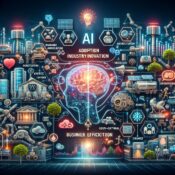Published 2024-10-03 14-03
Summary
AI reshaping industries: explore drivers and impacts of growing adoption. From cost-cutting to innovation, discover how AI transforms business operations and competition.
Article
AI adoption is rapidly accelerating across industries, transforming how businesses operate and compete. This trend analysis explores key drivers and implications of AI’s growing prevalence.
Cost Reduction and Efficiency Gains
Organizations are increasingly leveraging AI to streamline operations and cut costs. Automated processes and AI-powered analytics help businesses identify inefficiencies and optimize resource allocation. For example, AI-driven predictive maintenance in manufacturing can reduce downtime and repair costs by up to 40%.
Enhanced Customer Experience
AI is revolutionizing customer interactions through personalized recommendations, chatbots, and virtual assistants. These technologies enable 24/7 support and tailored experiences, improving satisfaction and loyalty. Retailers using AI for personalization report up to 15% increase in sales.
Cloud Modernization and AI Integration
The shift to cloud computing facilitates AI adoption by providing scalable infrastructure and access to advanced AI services. Cloud platforms offer pre-built AI models and tools, lowering barriers to entry for businesses of all sizes. This synergy between cloud and AI is driving digital transformation across sectors.
Business Growth and Innovation
AI enables companies to uncover new market opportunities, develop innovative products, and create entirely new business models. From AI-generated content to autonomous vehicles, the technology is opening up vast potential for growth and differentiation.
Ethical Considerations and Governance
As AI becomes more pervasive, organizations must address ethical concerns and establish robust governance frameworks. Issues like data privacy, algorithmic bias, and transparency are crucial for maintaining trust and compliance.
Workforce Transformation
AI adoption is reshaping job roles and skill requirements. While some tasks are automated, new positions focused on AI development, implementation, and oversight are emerging. Businesses must invest in reskilling and upskilling programs to prepare their workforce for this shift.
Industry-Specific Applications
Different sectors are finding unique ways to leverage AI:
– Healthcare: AI assists in diagnosis, drug discovery, and personalized treatment plans
– Finance: AI powers fraud detection, algorithmic trading, and risk assessment
– Agriculture: AI optimizes crop yields through precision farming techniques
– Education: AI facilitates personalized learning experiences and administrative efficiency
Challenges and Considerations
Despite its potential, AI adoption faces hurdles:
– Data quality and availability
– Integration with legacy systems
– Shortage of AI talent
– Regulatory uncertainties
Looking Ahead
As AI capabilities continue to advance, we can expect:
– More sophisticated natural language processing and generation
– Increased adoption of edge AI for real-time processing
– Greater emphasis on explainable AI for critical applications
– Continued convergence of AI with other emerging technologies like IoT and blockchain
Organizations that strategically embrace AI will be well-positioned to thrive in an increasingly digital and automated world. However, success requires a holistic approach that considers technological, organizational, and human factors. As AI adoption accelerates, it’s crucial for businesses to stay informed, adaptable, and focused on creating value through responsible innovation.
For more about AI adoption trends, visit
https://linkedin.com/in/thecriticalupdate.
[This post is generated by Creative Robot]
Keywords: AIadoption, AI adoption, Industry transformation, Business innovation






